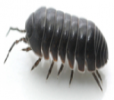
Problems with Sow and Pill Bugs are controllable under professional care. Our treatment goal is to stop a problem at its source so it doesn’t keep coming back. Using state-of-the art equipment and methods, our licensed exterminators will inspect your home’s environment and construction to identify the problem and determine the best course of action. Contact us today!
Sowbugs and Pillbugs are similar-looking pests and they are more closely related to shrimp and crayfish than to insects. They are actually crustaceans that have adapted to completely living on land and they normally live in moist environments outdoors but occasionally end up in buildings. They do not bite, sting, or transmit diseases, nor do they infest food, clothing or wood. They are merely a nuisance pest.
They can range in size from 1/4 to 1/2 inch long and are dark to slate gray. On their segmented bodies, there are seven pairs of legs and two pairs of antennae. Sowbugs also have two tail-like appendages which project out from the rear end of the body. Pillbugs have no posterior appendages and can roll up into a tight ball when disturbed.
These bugs are scavengers and feed mainly on decaying organic matter. They occasionally feed on young plants and thrive only in areas of high moisture. They tend to remain hidden during the day and are common under mulch, along grass lines and sideways, compost, boards, stones, flower pots, and other items resting on damp ground.
At night they venture out and feed on decomposing organic material, including mulch and grass clippings. They will feed on the tender foliage, stems and roots of young garden vegetable transplants, seedlings and bedding plants.
As pests, these creatures invade crawl spaces, damp basements and first floors of houses at ground level. They usually gain access under doors, through voids in concrete block walls and small gaps around foundations. They do not survive more than a few days without very high moisture.
Application of insecticides along baseboards and other interior living areas of the home are of little use in controlling these pests because the die without adequate moisture. The most effective, long-term measure for reducing indoor entry of these pests is to minimize moisture and hiding places near the foundation. This means that leaves, grass clippings, and old rotting mulch, needs to be moved away from foundations. Also other items such stones, boxes, and boards need to be removed or raised off the ground.
Water needs to be diverted away from the foundation wall with properly functioning gutters, down spouts and splash blocks. Leaking faucets, water supply pipes and drains, should be repaired. Homes with poor drainage may need the ground sloped to so that surface water drains away from the building. Humidity in crawl spaces and basements should be reduced by providing adequate ventilation, sump pumps, polyethylene soil covers, drains, and barriers.
Any cracks and openings in the foundation walls need to be repaired, and gaps around the bottoms of doors and basement windows need to be sealed. Installing tight-fitting door sweeps or thresholds at the base of all exterior entry doors will also help.